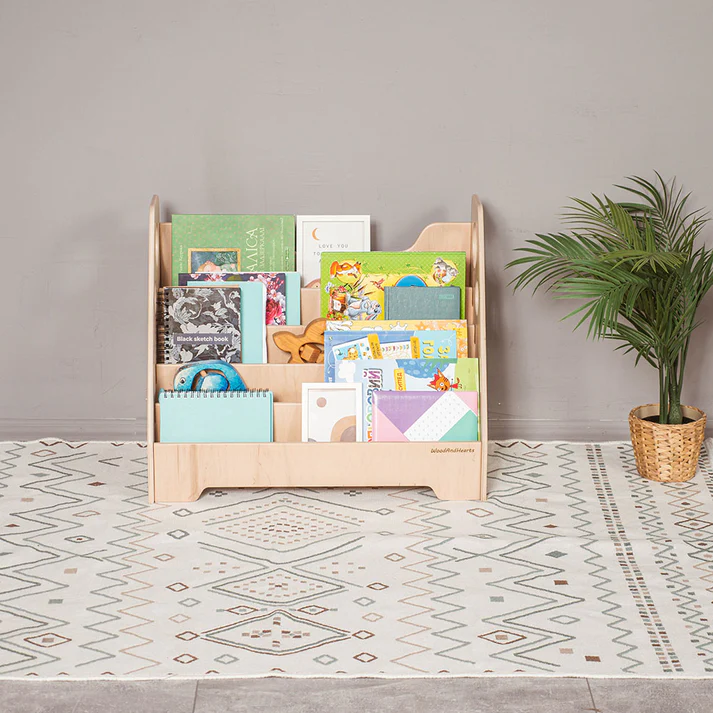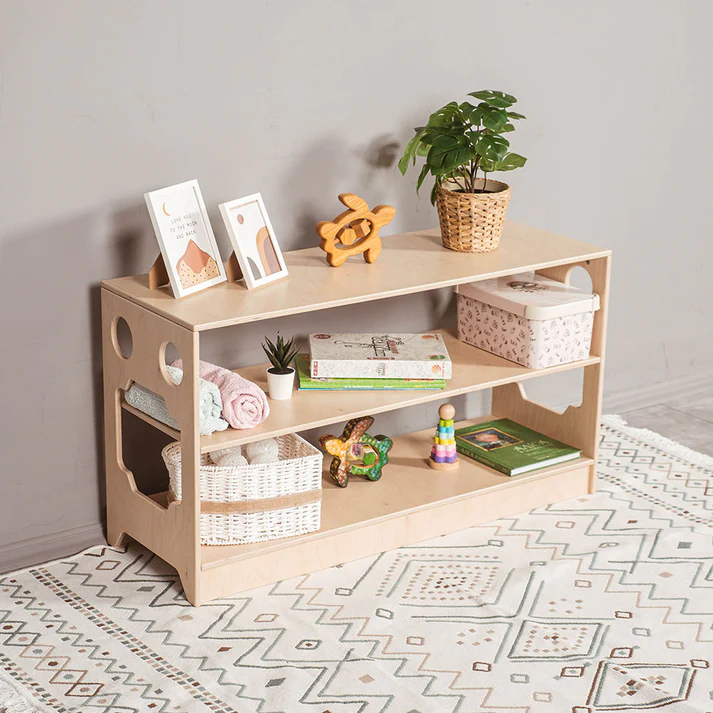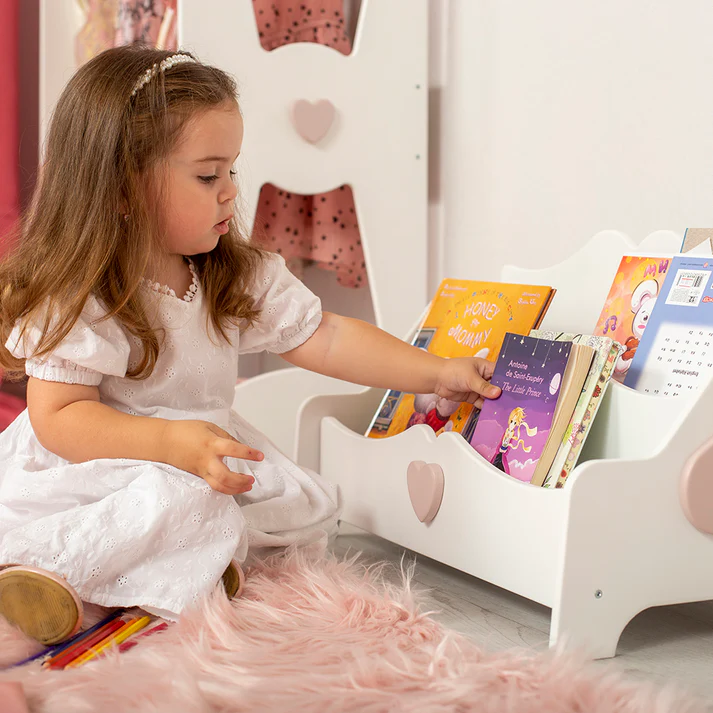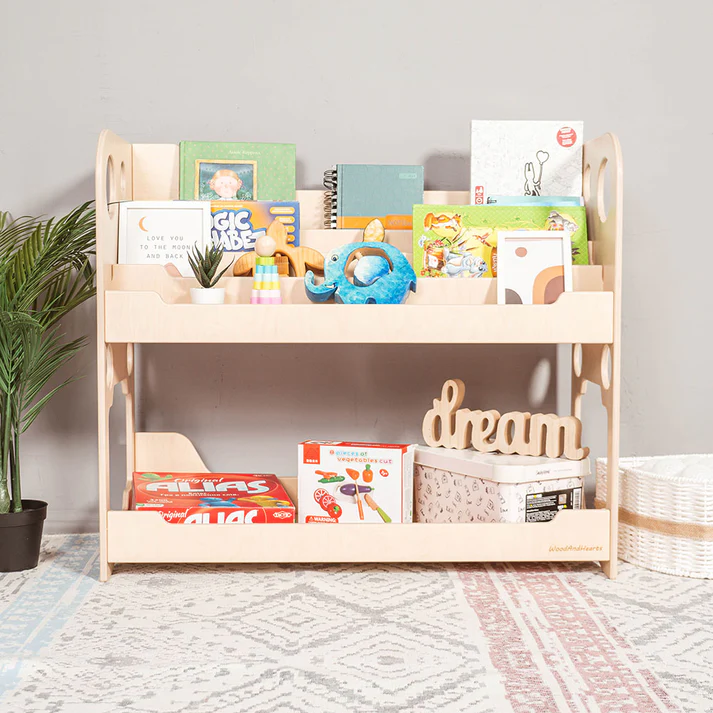Montessori Bookshelf Essentials: Creating an Engaging Learning Environment for Children
A Montessori bookshelf is more than just a peice of furniture; It is a tool that fosters independence and curiosity in children. I’ve seen firsthand how a well-designed Montessori book shelf can significantly enhance a child’s learning environment. In this article, I’ll guide you through everything you need to know about this wonderful peice of furniture, the benefits, and how to choose and use them effectively.
What is a Montessori Bookshelf?
A Montessori bookshelf is designed with the child’s development in mind. Unlike traditional bookshelves, these are low to the ground, allowing easy access for children. They typically feature forward-facing shelves, which display books by their covers, not spines, making it easier for young children to choose what they want to read.
Main Developmental Advantages of a Montessori Bookshelf
Incorporating a Montessori book shelf into a child’s environment is more than a practical decision; it’s an investment in their holistic development. It goes beyond mere organization of books – it’s about creating an inviting space for exploration, learning, and growth. Let’s dive into how these shelves make a significant impact on young minds
Fostering Independence and Confidence
Through Self-directed Learning: A Montessori bookshelf is designed for children to access books and toys without adult help, fostering a sense of independence. When children choose their own books, they develop decision-making skills.
They Are Confidence Building: Successfully selecting and handling books on their own boosts children’s confidence in their abilities. An essential skill for their overall long term development.
Enhances Motor Skills
Fine Motor Development: The act of picking up books, turning pages, and placing them back on the shelf helps in refining fine motor skills, which are crucial for writing and other detailed activities.
Gross Motor Development: Reaching for, squatting to access lower shelves, and navigating around the bookshelf support gross motor development.
Encourages Cognitive Development
Literacy Skills: Regular access to books naturally improves literacy. Early exposure to letters, words, and concepts like story structure aids in language development.
Cognitive Skills: Choosing what to read and interacting with different types of books enhances cognitive skills like memory, attention, and problem-solving.
Promotes Organizational Skills
Categorization: Organizing books on different shelves or sections based on categories helps children understand how to categorize and organize information logically.
Responsibility: Regularly maintaining their montessori book shelf teaches children to take care of their belongings and understand the importance of keeping their space tidy.
Stimulates Curiosity and Imagination
Exposure to Diverse Topics: A well-stocked Montessori bookshelf exposes children to a variety of subjects, fostering curiosity about the world around them.
Imagination: Stories and illustrations in books ignite imagination, an important aspect of creative thinking and problem-solving.
Supports Emotional and Social Development
Empathy and Understanding: Books that depict various characters and scenarios help children understand and empathize with different emotions and social situations.
Shared Reading Experience: Sharing a book with a parent, caregiver, or peer on a Montessori bookshelf can become a social activity, enhancing relational skills.
Encourages Lifelong Learning
Love for Reading: By making reading an enjoyable and independent activity, Montessori bookshelves lay the foundation for a lifelong love of reading.
Foundation for Academic Success: Early exposure to reading and the habits developed around it can contribute significantly to future academic success.
Design Principles of A Montessori Bookshelf
Montessori bookshelves are uniquely designed with children in mind. Lets have a quick look at some of the main design features that would feature in the perfect Montessori Bookshelf:
Child-Centric Height and Accessibility
Low Height: Montessori bookshelves are designed to be low to the ground, making them easily accessible to young children. This encourages independence as children can reach and select books on their own.
Accessibility: Shelves are often spaced and designed in a way that even toddlers can easily see and pick out books, promoting autonomy in their learning journey.
Safety Considerations
Sturdy and Stable Design: These bookshelves are less likely to tip over, which is crucial for child safety.
Rounded Corners and Edges: Understanding that children are in a phase of exploring and might be unsteady on their feet, Montessori bookshelves often have rounded corners and edges to minimize the risk of injury.
Forward-Facing Shelves
Visibility of Book Covers: Montessori bookshelves are typically designed with forward-facing shelves displaying the front of the books. This feature is appealing to children, as they are more likely to be drawn to books with visible, interesting covers.
Encourages Exploration: When children can see the covers, they are more likely to explore different books.
Aesthetically Pleasing and Environmentally Friendly Materials
Natural Materials: Often made from natural, sustainable materials like wood, Montessori bookshelves not only look aesthetically pleasing but are also more environmentally friendly.
Harmonious with Home Décor: The design of a Montessori book shelf often complements a variety of home décor styles, making them a seamless addition to a family’s living space.
Adaptability and Flexibility
Adjustable Features: Some Montessori bookshelves come with adjustable shelf heights to accommodate growing children and different sizes of books.
Multipurpose Use: The design is often versatile, allowing the furniture to be used for other purposes as children grow, such as for storing toys or displaying artwork.
Simplicity and Functionality
Clutter-Free Design: The shelves are designed to hold a limited number of books, which encourages a clutter-free environment and makes it easier for children to make choices.
Functional Elegance: A Montessori book shelf often has a simple yet elegant design, focusing on functionality without unnecessary decorative elements.
Our Top Picks For A Montessori Bookshelf
Explore our top picks for a Montessori bookshelf, designed to create an organized, accessible, and child-friendly reading space that encourages independent exploration and a love for learning.
5 shelf Low Montessori Book shelf
Step into a captivating realm of literacy and wonder with this traditional Montessori bookshelf, where reading takes center stage, igniting a lifelong passion for knowledge and imagination in young hearts.
- Front-facing bookcase conforms to the Montessori method
- Includes 5 shelves and side panels with handles
- For kids from 1 to 6 years old
Montessori Floor Organizer, 3 Tier Bookshelf for Kiddos
The stylish bookshelf encourages children for active reading and supports their independent decision making.
- Age Range from 1 year to 6 years.
- Conforms to the Montessori method.
- The bookcase is made of high-class birch plywood.
- Absolutely non-toxic and safe Montessori furniture.
Front Facing Angel Moontessori Book shelf
Create a dream bedroom for your little angel with the Montessori furniture collection “Angel” by Woodandhearts.
- Furniture is designed for children from 1 to 6 years.
- Sturdy and Reliable. The bookcase is made of high-class birch plywood.
- Absolutely non-toxic and safe. All corners are rounded and carefully sanded smooth by hand.
Floor Standing Montessori Book Shelf for Kids Room
This floor-standing Open Shelf has 5 tiers for kid’s toys and books storage. At the sidewalls there are shapes cutouts, which help to handle and move the shelf unit with ease.
Montessori Wall Shelf
Experience the magic of Montessori principles with every inch of this thoughtfully designed wall shelf. It offers up not just organization but a canvas for your child’s growth and creativity.
The open Montessori wall shelf fosters toddlers’ independence, while its child-friendly features encourage kids to organize their space, find needed items on their own, and choose books or toys that capture their interest at any given moment
Organizing a Montessori Bookshelf Space
Curating the Book Selection
Variety and Relevance: Choose a mix of books that cater to the child’s current interests and developmental stage. Include both fiction and non-fiction, ranging from simple picture books to more complex stories as they grow.
Cultural and Linguistic Diversity: Incorporate books from different cultures and in different languages (if applicable), to broaden the child’s worldview.
Accessibility and Visibility
Front-Facing Display: Arrange the books so that their covers are visible. This display method is more engaging for young children, making it easier for them to choose books independently.
Easy Reach: Ensure that all books are within easy reach of the child. For younger children, this might mean placing the books on the lower shelves.
Rotation and Renewal
Regular Rotation: Keep the bookshelf dynamic and interesting by rotating the books regularly. This could be based on seasons, themes, or the child’s evolving interests.
Introduce New Books: Periodically introduce new books to stimulate curiosity and encourage new learning experiences.
Categorization and Theming
Thematic Organization: Organize books into themes or categories, such as animals, space, emotions, or everyday life. This not only makes finding books easier but also helps in learning categorization and classification.
Labels and Signs: For older children, consider using labels or small signs to denote different sections, which can aid in literacy skills and organization.
Interactive Elements
Incorporate Activity Areas: Beside or around the bookshelf, include interactive elements such as wooden puzzles, montessori toys, or art supplies related to the books’ themes.
Display Children’s Work: Use the bookshelf to display the child’s own artwork or projects related to the book themes, fostering a sense of pride and ownership.
Involving the Child
Participation in Organization: Involve the child in the organizing process. Let them decide which books they want to display and where, giving them a sense of control and responsibility.
Teaching Care and Maintenance: Educate the child on how to take care of books and the importance of keeping the bookshelf tidy, instilling a sense of responsibility and order.
Aesthetic Appeal and Comfort
Create a Reading Nook: If space allows, set up a comfortable reading nook near the bookshelf with cushions, a small chair, or a bean bag. This makes the area inviting and conducive to spending time reading.
Warm and Inviting Decor: Consider the overall aesthetic appeal. Soft lighting, warm colors, and a cozy environment can make the reading area more inviting.
Closing Thoughts From Me
A Montessori bookshelf is more than a storage space for books, it’s a gateway to a world of learning and discovery. By carefully selecting and organizing books, creating a conducive reading environment, and actively engaging with your child, you can significantly enhance their love for reading and learning.
FAQs
How often should I rotate the books on a Montessori bookshelf? It’s a good idea to rotate books every few weeks to maintain the child’s interest. However, keep favorites readily available.
Can I use a Montessori bookshelf for other items besides books? Absolutely! You can use it to display educational toys, art supplies, or anything else that encourages learning and creativity.
Are there any specific brands that make Montessori bookshelves? While there are brands that market specifically to the Montessori community, any bookshelf that meets the key criteria can serve as a Montessori bookshelf.
How do I ensure the bookshelf is safe for my child? Choose a sturdy bookshelf with no sharp edges, and secure it to the wall to prevent tipping.
Where is the best place to put a Montessori bookshelf in my home? Place it in a quiet, well-lit area of your home where your child feels comfortable, such as their bedroom.









